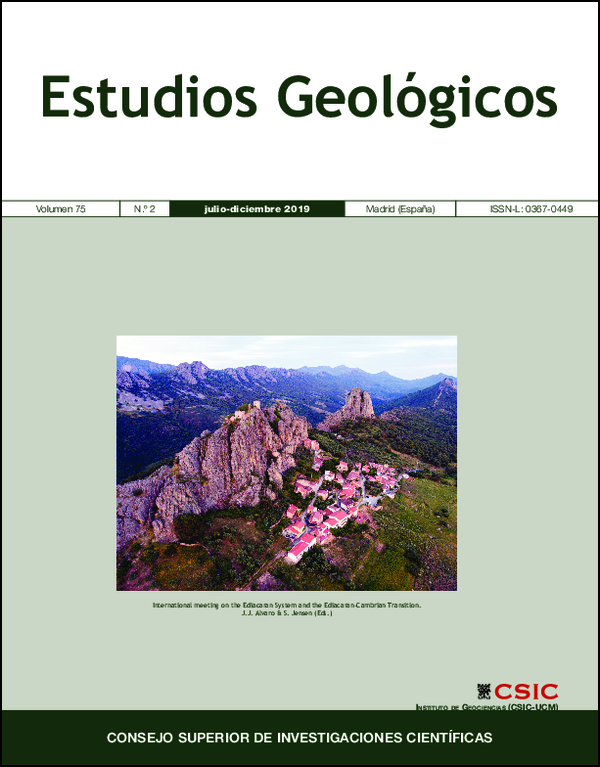Revisiting the age of the Asha Group in the South Urals
DOI:
https://doi.org/10.3989/egeol.43590.558Keywords:
Asha Group, South Urals, Ediacaran, Cambrian, Didymaulichnus, PalaeopascichnusAbstract
The Asha Group of the South Urals, initially erected by Albert Olli as Palaeozoic sedimentary complex, more than half a century ago was considered as a key section for the Vendian (Ediacaran) of the western slope of the South Urals. However, the ca. 1700 m-thick terrigenous sedimentary sequence is characterised by unusual low biodiversity of Ediacaran macrofossils, which might be explained by relatively young age of the Asha Group and possible mass extinction event in the end of Ediacaran Period. The relatively young age was confirmed by the U-Pb zircon date of 547.6±3.8 Ma obtained from the tuff in the lower part of the Basa Formation as well as finding of ichnospecies Didymaulichnus tirasensis in the upper part of Zigan formation. However, in 2018 it has been documented there the mass appearing of D. tirasensis in the lowermost part of the Basa Formation. Therefore, the Vendian (Ediacaran) age of the Asha Group of the South Urals can be revisited in favour to terminal Ediacaran- Cambrian or even early Cambrian.
Downloads
References
Garris, M.A. (1973). Late Precambrian of the Urals Timan and Mugodzhar. In: Geochronology of the USSR. Vol. 1. Precambrian (Polovinkina, Yu.I., ed.), Nedra, Leningrad, 133-146. [in Russian]
Grazhdankin, D.V.; Marusin, V.V.; Meert, J.; Krupenin, M.T. & Maslov, A.V. (2011). Kotlin Regional Stage in the South Urals. Doklady Earth Sciences, 440: 1222-1226. https://doi.org/10.1134/S1028334X11090170
Keller, B.M. (1963). Stratigraphy of the USSR. Vol. 2. Upper Precambrian. Gosnauchtekhizdat Literatury po Geologii I Gornomu Delu, Moscow, 716 pp. [in Russian]
Khain, V.E. & Lomize, M.G. (2005). Geotectonics and basics for geodynamics. KDU, Moscow, 560 pp. [in Russian]
Kolesnikov, A.V.; Marusin, V.V.; Nagovitsin, K.E.; Maslov, A.V. & Grazhdankin, D.V. (2015). Ediacaran biota in the aftermath of the Kotlinian Crisis: Asha Group of the South Urals. Precambrian Research, 263: 59-78. https://doi.org/10.1016/j.precamres.2015.03.011
Kolesnikov, A.V.; Danelian, T.; Gommeaux, M.; Maslov, A.V. & Grazhdankin, D.V. (2017). Arumberiamorph structure in modern microbial mats: implications for Ediacaran palaeobiology. Bulletin de la Société géologique de France, 188 (1-2): 57-66. https://doi.org/10.1051/bsgf/2017006
Kolesnikov, A.V.; Rogov, V.I.; Bykova, N.V.; Danelian, T.; Clausen, S.; Maslov, A.V. & Grazhdankin, D.V. (2018a). The oldest skeletal macroscopic organism Palaeopascichnus linearis. Precambrian Research, 316: 24-37. https://doi.org/10.1016/j.precamres.2018.07.017
Kolesnikov, A.V.; Liu, A.G.; Danelian, T. & Grazhdankin, D. (2018b) A reassessment of the problematic Ediacaran genus Orbisiana Sokolov 1976. Precambrian Research, 316: 197-205. https://doi.org/10.1016/j.precamres.2018.08.011
Kolesnikov, A.V. (2019) Stratigraphic correlation potential of the Ediacaran palaeopascichnids. Estudios Geológicos, 75 (2): e102. https://doi.org/10.3989/egeol.43588.557
Levashova, N.M.; Bazhenov, M.L.; Meert, J.; Kuznetsov, N.B.; Golovanova, I.V.; Danukalov, K.N. & Fedorova, N.M. (2013) Paleogeography of Baltica in the Ediacaran: paleomagnetic and geochronological data from the clastic Zigan Formation, South Urals. Precambrian Research, 236: 16-30. https://doi.org/10.1016/j.precamres.2013.06.006
Milanovsky, E.E. (1981). Aulacogens of ancient platforms: problems of their origin and tectonic development. Tectonophysics, 73: 213-248. https://doi.org/10.1016/B978-0-444-41956-9.50021-6
Olli, A.I. (1948) Eldest Strata of Western Flank of the Urals. SGU, Saratov, 413 pp. [in Russian]
Published
How to Cite
Issue
Section
License
Copyright (c) 2019 Consejo Superior de Investigaciones Científicas (CSIC)

This work is licensed under a Creative Commons Attribution 4.0 International License.
© CSIC. Manuscripts published in both the print and online versions of this journal are the property of the Consejo Superior de Investigaciones Científicas, and quoting this source is a requirement for any partial or full reproduction.
All contents of this electronic edition, except where otherwise noted, are distributed under a Creative Commons Attribution 4.0 International (CC BY 4.0) licence. You may read the basic information and the legal text of the licence. The indication of the CC BY 4.0 licence must be expressly stated in this way when necessary.
Self-archiving in repositories, personal webpages or similar, of any version other than the final version of the work produced by the publisher, is not allowed.















